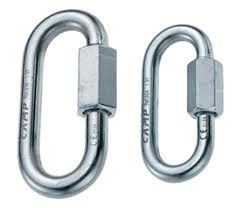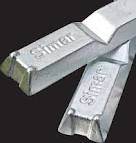Zinc - (Zn)
Low Melting Point:
786 Fahrenheit \
419 CelsiusBoiling point 1665 °F \ 907 °C
Zinc is a metallic chemical element, it has a white silver-gray color with a bluish tinge. It has a high resistance to atmospheric corrosion and a major use is as a protective coating for iron and steel sheet and wire. It is somewhat less dense than iron.

The metal is hard and brittle at most temperatures but becomes malleable between 212 - 302 °F / 100 -150 °C. Above 410 °F/ 210 °C, the metal becomes brittle again and can be pulverized by beating. Zinc is a fair conductor of electricity. For a metal, zinc has relatively low melting and boiling points Its melting point is the lowest of all the *transition metals aside from mercury and cadmium. As a dense, inexpensive, easily-worked material, zinc is used as a lead replacement. In the wake of lead concerns, zinc appears in lab weights, tire weights, and flywheels.
Applications:
The major application for zinc is Corrosion-resistant zinc plating of steel (hot-dip galvanizing). Roughly one third of all metallic zinc produced today is used in a process known as galvanization. During galvanization, an object that is subject to corrosion, such as an iron nail, is given a protective coating of zinc. Zinc is more reactive than iron or steel and thus will attract almost all local oxidation until it completely corrodes away. The zinc can be applied to an object by dipping it in a pool of molten zinc, but it is most often applied through an electroplating process. Sacrificial zinc anodes are used in cathodic protection systems to protect exposed iron from corrosion. Metallic zinc is also used to make dry cell batteries, roof cladding and "die castings". Zinc reacts readily with acids, alkalis and other non-metals. Extremely pure zinc reacts only slowly at room temperature with acids. Strong acids, such as hydrochloric or sulfuric acid, can remove the passivating layer and subsequent reaction with water releases hydrogen gas.
Alloys:
Zinc is used to make many useful alloys. Many alloys contain zinc, including brass, an alloy of zinc and copper. Other metals long known to form binary alloys with zinc are aluminum, antimony, bismuth, gold, iron, lead, mercury, silver, tin, magnesium, cobalt, nickel, tellurium and sodium. Brass, an alloy of zinc that contains between 55% and 95% copper, is probably the best known zinc alloy. Zinc is alloyed with lead and tin to make solder, a metal with a relatively low melting point used to join electrical components, pipes and other metallic items. Prestal®, an alloy containing78% zinc and 22% aluminum, is a strange material that is nearly as strong as steel but is molded as easily as plastic. Nickel silver, typewriter metal, spring brass and German silver are other common zinc alloys.
Casting:
Alloys of primarily zinc with small amounts of copper, aluminum, and magnesium are useful in die casting as well as spin casting, especially in the automotive, electrical, and hardware industries. These alloys are marketed under the name Zamak. An example of this is zinc aluminum. The low melting point together with the low viscosity of the alloy makes the production of small and intricate shapes possible. The low working temperature leads to rapid cooling of the cast products and therefore fast assembly is possible. Another alloy, marketed under the brand name Prestal, contains 78% zinc and 22% aluminum and is reported to be nearly as strong as steel but as malleable as plastic. This superplasticity of the alloy allows it to be molded using die casts made of ceramics and cement. It casts harder than aluminum for better wear, and zinc/aluminum alloys can approach cast iron in strength and durability.
Toxicity
Although zinc as an element supplement is an essential requirement for good health and is believed to possess antioxidant properties. However excess zinc can be harmful. Excessive absorption of zinc suppresses copper and iron absorption. The free zinc ion in solution is highly toxic to plants, invertebrates, and even vertebrate fish. In 1982, the United States Mint began minting pennies coated in copper but made primarily of zinc. The zinc content of some coins can cause zinc toxicity. With the new zinc pennies, there is the potential for zinc toxicosis, which can be fatal in large amounts to animals and humans if ingested.
In welding you don't weld galvanized steel as you are vaporizing the zinc coating into toxic fumes. Zinc burns in air with a bright bluish-green flame,
giving off TOXIC fumes of zinc oxide.
HEALTH EFFECTS: Irritation-Eye, Nose, Throat, Skin---Marked Respiratory Effects---Acute lung damage/edema Chronic(Cumulative)
Toxicity-Suspect Carcinogen or mutagen. Zinc - http://www.osha.gov/SLTC/metalsheavy/zinc.html
Production
Zinc is the 24th most abundant element in the Earth's crust. Zinc is the fourth most common metal in use, trailing only iron, aluminum, and copper with an annual production of about 12 million tones. About 70% of the world's zinc originates from mining, while the remaining 30% comes from
 recycling
secondary
zinc.
Commercially
pure zinc
is known
as Special
High
Grade,
often
abbreviated
SHG, and
is 99.995%
pure. In
2009 in
the
United
States,
55% or 893
thousand
tones of
the zinc
metal was
used for
galvanization.
Roughly
one
quarter of
all zinc
output, in
the United
States
is used in
hundreds
of other
forms of
zinc
compounds
for use in
other
industries.
recycling
secondary
zinc.
Commercially
pure zinc
is known
as Special
High
Grade,
often
abbreviated
SHG, and
is 99.995%
pure. In
2009 in
the
United
States,
55% or 893
thousand
tones of
the zinc
metal was
used for
galvanization.
Roughly
one
quarter of
all zinc
output, in
the United
States
is used in
hundreds
of other
forms of
zinc
compounds
for use in
other
industries.
Zinc Ingots - are currently selling in the 4.00 - 8.00 dollar range per pound.
TheFoundryZone.com
Accuracy of Information
The information on the Website is provided to you "as is" by TheFoundryZone.com in good faith and has been derived from sources believed by TheFoundryZone.com to be reliable and accurate at the time of providing it. TheFoundryZone.com does not guarantee the accuracy, completeness or currency of information. Use of the Website and its contents is at your own risk. See Web Site: Terms of Use.